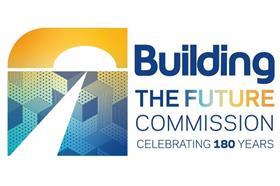Technological progress means we now need wider skill-sets than ever before if we are to meet the demands on the sector, writes Patricia Moore of Turner & Townsend
In the realm of construction, the universal echo about the “skills gap” continues to reverberate, a persistent challenge that demands a nuanced solution. To bridge this divide in the long run, a fundamental shift is required — one that revolves around effectively marketing our industry roles to captivate the imagination of the next generation.
It is the allure of the digital, technical and environmental dimensions within the construction sector that holds the key to securing a robust, diverse and skilled workforce for the future.


Embarking on a career in construction is an invitation to orchestrate remarkable achievements that span the spectrum, from monumental engineering endeavours that shape skylines to the subtle yet transformative decisions enhancing the fabric of everyday living and working spaces. These accomplishments not only imbue our professional lives with purpose but also instill a profound sense of pride in contributing to the built environment.
A snapshot survey conducted at the Building the Future conference in September underscored this concern, revealing that 72 percent of respondents lacked confidence in the industry’s ability to meet the demands of modern standards—expressing either ‘not confident at all’ or ‘not very confident’ sentiments.
Such concerns are not new, but the challenge is different now. The demands on the sector are greater and more urgent, while technological progress means that we need wider skillsets than ever before.
Values and value – capturing a sense of purpose across our teams
The good news is that our industry is great at problem solving. If we can apply the same blend of creativity and rigour that we use every day in our work, we can fix our own challenges.
With any project, we think about the result. So, let’s consider the end-game first when it comes to skills. Our ‘problem’ is not shortages per se, but how we overcome much bigger issues and, crucially, how we talk about them.
The built environment is one of the greatest contributors to global greenhouse gas emissions. At the same time, it is also the engine through which we will drive change: the industry that delivers new renewable energy transmission, that builds carbon capture clusters and that retrofits homes to make them warmer, more fuel-efficient and cheaper to run.
This goes hand in hand with the complex problem of equity. Societies globally and in the UK are seeing growing inequality when it comes to the distribution of wealth, health and happiness.
We should be attracting and inspiring talent in droves
Construction can be a game changer on this front. We build new communities, regenerate old ones, and connect them through transport and utility infrastructure. In doing so, we are creating social value in the places themselves, but also through the distribution of wealth and knowledge into the development supply chain.
If we talk about the sector in these terms, we should be attracting and inspiring talent in droves. These are the big issues for us as individuals and within our own communities, to longstanding career builders and to the next generation.
The problem is that our industry does not talk like this nearly enough; we need to get better at telling our story.
Re-evaluating valuation
Celebrating such successes relies on providing proof and that means rethinking the metrics we are using to meet the more complex goals that we’re now setting ourselves.
How we do this has changed unrecognisably through my own career. The days of measuring a straightforward triangle of cost, time and quality are fast fading: we are now assessing a matrix of criteria from carbon and ecological footprints to socio-economic impacts around diversity, inclusivity, and accessibility.
We are no longer weighing up “quantities” but considering the benefits and trade-offs of complex decisions – from retrofit vs rebuild, to the opportunity around design for manufacture.
Data is how we will tell the industry’s story. To do so we have a powerful force on our side when we look at the rapid and seemingly limitless potential in digital technology to support us as we benchmark, forecast, control and evaluate the outcomes that the industry’s work is delivering.
New career pathways for new success criteria
If we think about the future in these terms, we find the answer to our skills question: to invest in attracting and building increasingly blended technical and digital teams. Excellence in engineering design now dovetails inextricably with the ability to visualise results as we move towards a world of digital twins and the whole life appraisal. Likewise, the logic and rigour of programme management is already deeply embedded with experience in managing vast datasets – and keeping them secure.
The career challenge we have is to find and nurture this talent. Our part of the industry has relied for a long time on traditional graduate routes into cost and project management. This still delivers, but uptake is consistently falling, and broader skills are needed too. We now have over 200 sustainability consultants in the UK, and 250 digital consultants. We’ve moved from a world of spreadsheets to sophisticated apps that put data into the palm of our hands – and are already looking beyond that to the possibilities of AI.
From the carbon-conscious visionary thinker to the computer scientist looking to make a difference, we offer careers to solve the world’s biggest challenges
The industry needs the skills to match. We have radically increased the number of apprentices in our cohort – taking recruits on earlier and working with them to define the career pathways that work for them and for us. We urge others to do the same.
Nationally, we are optimistic that plans to increasingly open apprenticeship applications through a UCAS-like programme from next year will help to support this push toward earlier careers.
The day when we stop talking about skills shortages will come only when we have landed this message: from the carbon-conscious visionary thinker to the computer scientist looking to make a difference, we offer careers to solve the world’s biggest challenges. Join our sector and take us in new directions; stay with us and see the results of your work for decades to come.
Patricia Moore is managing director, UK, for Turner & Townsend
The Building the Future Commission

The Building the Future Commission is a year-long project, launched to mark Building’s 180th anniversary, to assess potential solutions and radical new ways of thinking to improve the built environment, with thanks to our national headline sponsors Fenwick Elliott and Gleeds.
The major project’s work will be guided by a panel of 19 major figures who have signed up to help guide the commission’s work culminatuing culminate in a report published at the end of the year.
The commissioners include figures from the world of contracting, housing development, architecture, policy-making, skills, design, placemaking, infrastructure, consultancy and legal.
They include Katy Dowding, executive vice president at Skanska, Richard Steer, chair of Gleeds, Lara Oyedele, president of the Chartered Institute of Housing, Mark Wild, former boss of Crossrail and chief executive of SGN, and Simon Tolson, senior partner at Fenwick Elliott. See the full list here.
The project is looking at proposals for change in eight areas:
- Education and skills
- Housing and planning
- Energy and net zero
- Infrastructure
- Building safety
- Project delivery and digital
- Workplace culture and leadership
- Creating communities
>> Editor’s view: And now for something completely positive – our Building the Future Commission
>> Click here for more about the project and the commissioners
Building the Future is also undertaking a countrywide tour of roundtable discussions with experts around the regions as part of a consultation programme in partnership with the regional arms of industry body Constructing Excellence. There is also a young person’s advisory panel.



























No comments yet